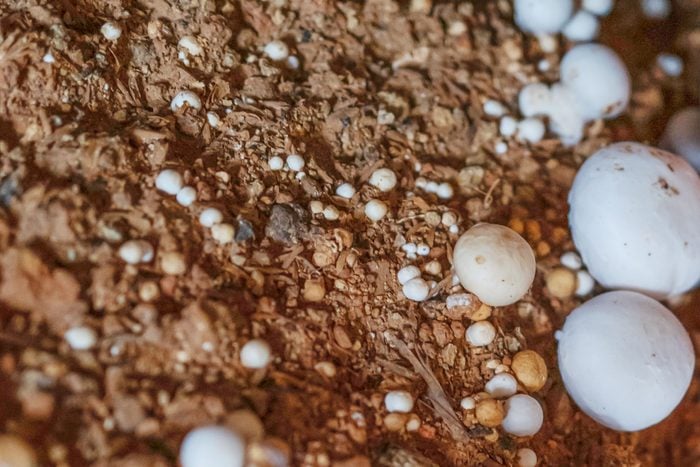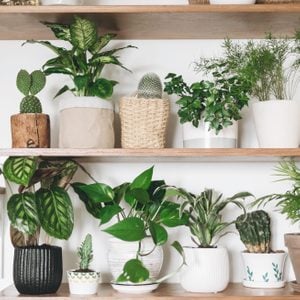Here’s What It Means If You See White Fungus Balls in Soil
Updated: Feb. 15, 2023

They pop up seemingly out of nowhere, but should you be concerned? We got the scoop on those strange, little white fungus balls in your soil.
When it comes to gardening, there’s a lot to learn. Even people with a green thumb may need to know how to revive a dead plant or wonder what on earth that powdery mildew on plants is. And have you ever noticed white fungus balls suddenly appearing in your yard, garden beds or even indoor-plant containers? Where did they come from, and what should you do about them?
The good news is that white fungus balls in soil are not as concerning as they may sound. In fact, some people find them charming, while others feel that, just like brown tips on leaves, they disturb the beauty of well-manicured lawns and gardens. And while they’re generally harmless, you’ll definitely want to exercise caution in certain instances.
Here’s what you need to know about what it means when they pop up, if they pose a danger to your family or your pets, and how to get rid of them.
What are white fungus balls in soil?
There’s another name for those little white fungus balls in soil: mushrooms! They seem to pop up out of nowhere, but they’ve actually likely been there for a while, just out of sight. You see, mushrooms have two parts—an underground mass that lives for a long time in the soil, and aboveground balls or buttons that appear and disappear quickly.
And they’re actually great for your soil. “I call mushrooms nature’s recyclers,” says Greg Mueller, PhD, a mycologist (fungus expert) and the chief scientist at the Chicago Botanic Garden. That’s because the underground portions of the fungi live off dead material like fallen branches and leaves, decomposing them. That decomposed matter, in turn, provides nutrition to your lawn and garden plants, so the presence of mushrooms means your soil is healthy.
The function of the balls you see aboveground is to disperse spores that can produce new mushrooms. You often see them in white, but they may be brown as well. The balls can pop out of the ground suddenly, especially after a rainstorm, and generally reach a mature size within one to four days. Wind carries the ball’s spores, and when the spores land in the right spot, they become new fungi.
“Mushroom balls in the soil can last for a couple of hours, a week or two weeks,” said Mueller. The underground mass of the fungus, however, will survive as long as it has dead material to live off of—possibly for centuries. So there you have it: one of the biggest lawn mysteries solved!
Do white fungus balls harm plants?
White fungus balls in soil are almost never a problem for plants in the garden. The exception is when the underground growths start to crowd out desirable plants. If your plants start to shrink and there are mushrooms nearby, check the ground for a mass of fungus, then dig it out.
FYI, if you see an unpleasant-looking white, yellow, brown or black blob that forms in a layer on your lawn, this is a different type of growth called slime mold. It used to be classified as fungus, and it does resemble it (the top is comprised of tiny balls), but it’s actually a soil-dwelling amoeba. While gross, it’s also generally not harmful to your lawn. But if the patches get big, they can block sunlight and cause your grass to turn yellow. You can easily remove it, though, with mowing, light raking or by hosing it down.
Do white fungus balls smell bad?
Some do. If you’re digging in the garden and come across a bunch of golf ball–size white spheres, you may have found the immature buttons of the aptly named stinkhorn. “Stinkhorns develop rapidly, sometimes growing up to four to six inches per hour, and can generate enough force to break through asphalt,” according to the University of Wisconsin Horticultural Extension. And once they reach their mature, rocket-shaped appearance, Mueller says, “they really do stink.” Fortunately, they don’t last long. The rotten smell attracts flies, which disperse the mushroom’s spores.
Do white fungus balls harm people?
Poisonings by mushrooms are rare but serious. In 2016, eating toxic wild mushrooms resulted in 1,328 emergency room visits and 100 hospitalizations. And every year between 1999 and 2016, about three mushroom-related deaths were reported by the National Poison Data System. While ingesting the wrong mushrooms can cause heart, kidney and liver damage, among other problems, touching any kind of mushroom is safe, says Mueller.
Only a small percentage of mushrooms cause illness in humans, and an even smaller number are potentially fatal. Unfortunately, some of the most lethal mushrooms look similar to harmless ones. For instance, the death cap mushroom, which produces the most deadly substance occurring in nature, resembles the very common white puffball, Mueller notes. The CDC advises against foraging mushrooms unless you are an expert, adding: “The public should be aware that children should be supervised when playing outside in areas where mushrooms might grow.” FYI, here are a few other toxic plants you might have in or around your home.
Do white fungus balls harm pets?
You already know not to eat mushrooms growing on the ground, but your dog probably didn’t get that memo. Unfortunately, dogs are attracted to the fishy smell in some fungi and can be harmed by certain kinds of mushrooms that are safe for humans, according to the North American Mycological Association.
The most common symptoms of poisoning are vomiting and diarrhea, which can lead to weakness and dehydration. Problems can start as soon as 15 minutes after your pet eats a mushroom but can also happen many hours later. In the most serious form of poisoning—from death caps and their ilk—GI symptoms don’t begin until 6 to 24 hours after ingestion. “The pet becomes jaundiced, weak, lethargic and sometimes comatose,” writes VCA Animal Hospitals. “What starts as mild GI upset quickly progresses to full-blown liver failure that can result in death in a matter of days.” All this is reason to consult a vet anytime your canine experiences gastrointestinal symptoms after being outside.
If you see your dog eat one of those white fungus balls in soil (or any other potentially toxic plant for pets), pluck the mushroom, wrap it in a wet paper towel (to keep it from deteriorating) and bring it to your vet. You can also photograph the mushroom if you are careful to do it from all angles so that identifying characteristics such as the undersides of the cap are shown. But prevention, of course, is better than treatment. So if your pet has free rein in your yard, remove all the mushrooms, making sure to check the yard regularly, since they pop up fast.
Cats, on the other hand, show little interest in eating mushrooms, so this generally won’t be a problem.
Do white fungus balls harm houseplants?
The simple answer is no. If your houseplant is dying, mushrooms are not the cause. “It does not hurt plants, but it may not be aesthetically appealing,” says Mueller. They are growing inside your house because the potting soil you’re using has been contaminated with the spores of these heat-loving inhabitants.
But these mushrooms can be toxic, and if you have young children in your home, you’ll want to take precautions to avoid a dangerous situation. If you see these mushrooms in your houseplants, pull them out immediately.
How do you get rid of white fungus balls in soil?
Getting rid of the caps of fungi in the soil is relatively simple. “Most people just pluck them and toss them out,” Mueller says. You can also mow them down in lawns. Neither of these activities, though, will eliminate the fungal mass below the ground, so new mushrooms may pop up in favorable conditions, such as after a rain. What about packaged fungicides? Nope! They work better at controlling fungal diseases like powdery mildew, and regardless, they can cause a lot of damage to beneficial microorganisms in the soil.
If you really want to clear an area—if, say, a recurring patch is impinging on your hostas—follow these steps:
- Dig up as much of the mushroom (both aboveground and underground) as you can.
- Put what you’ve dug up in a plastic bag so you don’t spread the spores that are in the mushroom cap. Then seal the bag and toss it.
- Mix a few drops of dish detergent with water, then spray the liquid on the ground you’ve just exposed. This solution is a mild fungicide.
Can you prevent white fungus balls from forming in soil?
Yes, at least temporarily. Mushrooms feed off dead plant matter such as fallen leaves and decaying mulch, so you can reduce their likelihood of appearing by raking leaves from your lawn and garden, removing thatch (a layer of roots and dead grass on the lawn) with a mower or rake, lowering your use of mulch and picking up pet waste. You can also prevent moisture from building up and encouraging the growth of mushrooms by making sure downspouts don’t empty into your lawn, as well as aerating your grass by digging regular holes with a garden fork or a special machine called an aerator.
Will these activities eliminate mushrooms from your property? Probably not, answers Mueller. You could, instead, take out the fungus balls that annoy you or pose a danger to children and dogs, then learn how to compost to get even healthier soil … or simply contemplate the strange ways of nature.
Sources:
- Greg Mueller, PhD, mycologist and chief scientist at Chicago Botanic Garden
- Alabama A&M & Auburn Universities Extension: “Slime Molds on Home Lawns”
- Wisconsin Horticulture Division of Extension: “Stinkhorns”
- CDC: “Health Care Utilization and Outcomes Associated with Accidental Poisonous Mushroom Ingestions — United States, 2016–2018”
- Mycologia: “Mushroom poisoning epidemiology in the United States”
- North American Mycological Association: “Mushroom Poisonings in Dogs and Cats”
- VCA Animal Hospitals: “Mushroom Toxicity”
- Penn State Extension: “Managing Thatch in Lawns”



